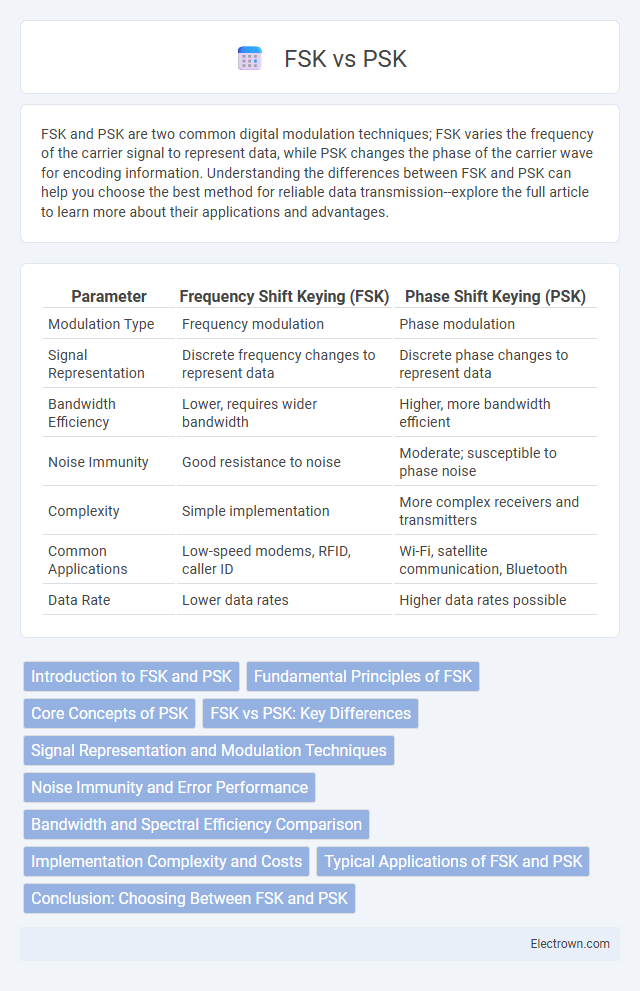FSK and PSK are two common digital modulation techniques; FSK varies the frequency of the carrier signal to represent data, while PSK changes the phase of the carrier wave for encoding information. Understanding the differences between FSK and PSK can help you choose the best method for reliable data transmission--explore the full article to learn more about their applications and advantages.
Table of Comparison
| Parameter | Frequency Shift Keying (FSK) | Phase Shift Keying (PSK) |
|---|---|---|
| Modulation Type | Frequency modulation | Phase modulation |
| Signal Representation | Discrete frequency changes to represent data | Discrete phase changes to represent data |
| Bandwidth Efficiency | Lower, requires wider bandwidth | Higher, more bandwidth efficient |
| Noise Immunity | Good resistance to noise | Moderate; susceptible to phase noise |
| Complexity | Simple implementation | More complex receivers and transmitters |
| Common Applications | Low-speed modems, RFID, caller ID | Wi-Fi, satellite communication, Bluetooth |
| Data Rate | Lower data rates | Higher data rates possible |
Introduction to FSK and PSK
Frequency Shift Keying (FSK) and Phase Shift Keying (PSK) are fundamental digital modulation techniques used in communication systems. FSK conveys data by varying the frequency of the carrier wave, while PSK transmits information through changes in the phase of the carrier signal. Understanding these modulation methods helps optimize your digital communication performance and system design.
Fundamental Principles of FSK
Frequency Shift Keying (FSK) encodes digital data by shifting the carrier wave between distinct frequencies, typically representing binary states 0 and 1. It utilizes two or more discrete frequency tones, where each frequency corresponds to a specific symbol or bit pattern, ensuring robust signal integrity in noisy environments. FSK's modulation technique relies on frequency variation rather than amplitude or phase changes, making it less susceptible to signal degradation and enabling reliable communication over various mediums.
Core Concepts of PSK
Phase Shift Keying (PSK) encodes data by varying the phase of a carrier signal, representing digital information through distinct phase changes, which enhances bandwidth efficiency compared to Frequency Shift Keying (FSK). This technique aligns phase angles with specific bit patterns, enabling higher data rates and improved spectral efficiency for your communication systems. PSK's robustness against noise and ability to support multiple phase states make it a preferred choice in digital modulation schemes like BPSK and QPSK.
FSK vs PSK: Key Differences
Frequency Shift Keying (FSK) and Phase Shift Keying (PSK) differ primarily in their modulation techniques, with FSK varying the carrier frequency to represent data while PSK changes the carrier phase. FSK tends to be more resilient to signal amplitude variations and noise, making it suitable for low-speed data transmission in noisy environments. Your choice depends on the application's need for robustness or bandwidth efficiency, as PSK generally offers higher spectral efficiency and faster data rates compared to FSK.
Signal Representation and Modulation Techniques
Frequency Shift Keying (FSK) modulates digital data by varying the frequency of the carrier wave between discrete values corresponding to binary states, representing signals as distinct frequency tones. Phase Shift Keying (PSK) encodes data by shifting the phase of the carrier wave between predefined angles, enabling efficient utilization of bandwidth with constant amplitude signals. Both modulation techniques maintain constant amplitude, but FSK relies on frequency variation for signal representation, while PSK uses precise phase shifts to encode information.
Noise Immunity and Error Performance
Frequency Shift Keying (FSK) generally offers better noise immunity compared to Phase Shift Keying (PSK) because FSK signals are less susceptible to phase noise and amplitude variations, making it more reliable in noisy environments. Error performance in PSK often surpasses FSK under ideal conditions, with lower bit error rates due to coherent detection techniques, but PSK is more sensitive to phase distortion and fading. Your choice between FSK and PSK should consider the specific noise characteristics of the communication channel to optimize error performance and reliability.
Bandwidth and Spectral Efficiency Comparison
Frequency Shift Keying (FSK) generally requires more bandwidth than Phase Shift Keying (PSK) due to its use of distinct frequency tones to represent data symbols. PSK offers higher spectral efficiency by modulating the phase of a carrier wave, allowing closer symbol spacing without increased bandwidth. This makes PSK more suitable for bandwidth-limited communication systems where maximizing data throughput per Hertz is critical.
Implementation Complexity and Costs
FSK (Frequency Shift Keying) typically involves simpler hardware designs using oscillators and filters, resulting in lower implementation complexity and costs compared to PSK (Phase Shift Keying). PSK systems require precise phase synchronization and more sophisticated signal processing components, increasing both design complexity and expenses. Your choice depends on cost constraints and the need for performance accuracy, with FSK being more cost-effective for basic applications.
Typical Applications of FSK and PSK
Frequency Shift Keying (FSK) is commonly used in low-bandwidth applications such as remote controls, caller ID systems, and legacy radio communication due to its robustness in noisy environments. Phase Shift Keying (PSK) finds widespread use in modern digital communication systems, including Wi-Fi, satellite communication, and RFID, where higher data rates and spectral efficiency are required. Both modulation schemes are pivotal in their respective domains, with FSK favored for simplicity and PSK for complex signal processing capabilities.
Conclusion: Choosing Between FSK and PSK
FSK offers robustness in noisy environments due to its frequency variations, making it ideal for low-bandwidth and long-distance communications. PSK provides higher spectral efficiency and faster data rates through phase changes, suited for bandwidth-constrained systems requiring higher throughput. Selecting between FSK and PSK depends on the application's noise tolerance, bandwidth availability, and desired data transmission speed.
FSK vs PSK Infographic

 electrown.com
electrown.com